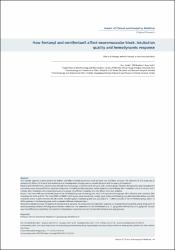How fentanyl and remifentanil affect neuromuscular block, intubation quality and hemodynamic response
Citation
Kazdal, H., Bombaci, E. & Aydin, N. (2022). How fentanyl and remifentanil affect neuromuscular block, intubation quality and hemodynamic response. Annals of Clinical and Analytical Medicine, 13(1), 40-44. http://doi.org/10.4328/ACAM.20832Abstract
Aim: Opioids suppress noxious autonomic reflexes and affect multiple parameters such as heart rate and blood pressure. The objective of this study was to compare the effects of fentanyl and remifentanil on hemodynamic changes, neuromuscular blockade and the quality of intubation.
Material and Method: Sixty patients were divided into three groups as remifentanil, fentanyl, and a control group. Patients' demographics and hemodynamic parameters were measured before anesthesia induction, immediately after induction, before intubation, immediately after intubation and at 3 minutes and 5 minutes after intubation and compared between the groups. In addition, intubation and side effects were also analyzed.
Results: The mean SBP was remarkably lower in the remifentanil group checked against both fentanyl and control groups after induction and 5 minutes after intubation (for both, p<0.05). The mean DBP and MAP and HR values were statistically notably lower in the remifentanil group after induction, before and after intubation and at 3 and 5 minutes (for all p<0.05). Excellent-good intubation quality was succeeded in 17 (85%) patients in the remifentanil group and in 16 (80%) patients in the fentanyl group, with no notable difference between them.
Discussion: Opioids increase the quality of intubation and suppress the undesirable hemodynamic response to intubation by blocking the central integration of sensory pathways without affecting neuromuscular conduction. The administration of remifentanil as a 1.5 mu g/kg bolus followed by a 0.3 mu g/kg/min infusion was more effective in controlling the undesired hemodynamic responses induced by tracheal intubation and laryngoscopy.


















